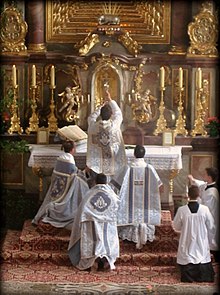Velum (liturgical clothing)
The shoulder velum (from the Latin velum "sail, cloth, cover") is a rectangular cloth that is used in the Roman Catholic liturgy and is used to cover the hands when they touch certain objects in worship.
The velum rests on the shoulders and back, its ends drop over the front right and left over the wearer's chest. The ends can be connected in front of the chest with a clasp or straps so that the velum cannot slip off the shoulders. The velum should be made of silk. Blessing and subdiaconal velums usually have an embroidered or sewn ornament in the middle and are decorated with braids at the ends, the acolyte velum is usually unadorned.
Wearing the velum is understood as a sign of awe. It also largely prevents the precious liturgical implements and vessels, which are mostly made of precious metals such as silver or gold, from being touched with bare hands and thus from tarnishing the touched areas.
Sacrament velum, blessing velum
The sacramental or blessing veil is put on the priest or deacon as a sacramental blessing during Eucharistic devotions and Eucharistic processions when he is wearing the Most Holy . Regionally, the blessing velum was also worn in the event of a mistake .
According to the regulations on the liturgical colors, the sacramental velum is always white. The inside is usually lined with a thin fabric, and pockets are sewn on the left and right, in which the wearer of the monstrance puts his hands so that he does not touch the monstrance with bare hands. Blessing veils are often made of silk brocade and can have an ornately decorated clasp. Sometimes they are made in the same way as an associated smoke jacket .
A sacramental velum came into use relatively late. It was first mentioned around 1400 in a Roman ordo during the transfer of the Holy of Holies in the Good Friday liturgy and was initially not placed around the shoulders, but lay over the cleric's left shoulder. The front end of the head of the cloth covered the chalice with the consecrated hosts , the other end hung down behind the shoulder.
Subdiaconal Velum
Since the 8th or 9th century it was customary in the Roman rite that the paten was hidden under the corporal from the sacrifice until after the Lord's Prayer , as a “symbol of the Lord hiding himself from his suffering” or “the hiding of the disciples at the beginning of suffering ”. The priest pushed the paten under the corporal. In the solemn mass, the paten was worn veiled by a cleric, initially by an acolyte in the role of patenarius , who used a hand veil - the sindon - for this.
Around the 11th century, the task passed to the subdeacon in many places, if not everywhere . This initially used his maniple , then a mappula , a strip of cloth over his right shoulder, the rear end hanging down the back of the subdeacon. From the 15th century at the earliest, the subdeacon used a shoulder velum in its present form to wear the veiled paten, as was common until the liturgical reform of 1970 and is still practiced today in the extraordinary form of the Roman rite. The velum was decorated in the middle and its color was based on the color of the chasuble.
Acolyte Velum
A Handvelum to protect even then sometimes precious mitres - the velum ad tenendam mitram - came into use in the 13th century; it was used by the acolytes who held the bishop's miter in the pontifical office while the latter had taken it off, but was initially not a shoulder velum but a cloth.
Today the altar boys ( signiferi ), who hold the episcopal insignia with staff and miter at the pontifical office, wear a shoulder velum without jewelry. It is intended to prevent tarnishing of the staff or stains on the miter. The velum is white or depends on the liturgical color that applies to the day or occasion.
literature
- Joseph Braun : The Liturgical Paraments in the Present and Past. A manual of paramentics. Second, improved edition, Herder, Freiburg (Breisgau) 1924, pp. 228-231 (reprographic reprint: Nova and Vetera, Bonn 2005, ISBN 3-936741-07-7 ).
Web links
Individual evidence
- ↑ Joseph Braun: The Liturgical Paraments in the present and past. Second, improved edition, Freiburg (Breisgau) 1924, p. 228f.
- ^ Josef Andreas Jungmann SJ: Missarum Sollemnia. A genetic explanation of the Roman mass. Volume 1, Herder Verlag, Vienna, Freiburg, Basel, 5th edition 1962, p. 155.
- ^ Josef Andreas Jungmann SJ: Missarum Sollemnia. A genetic explanation of the Roman mass. Volume 2, Herder Verlag, Vienna, Freiburg, Basel, 5th edition 1962, p. 77 note 105.
- ↑ Joseph Braun: The Liturgical Paraments in the present and past. Second, improved edition, Freiburg (Breisgau) 1924, p. 229ff.
- ↑ Joseph Braun: The Liturgical Paraments in the present and past. Second, improved edition, Freiburg (Breisgau) 1924, pp. 229f.

